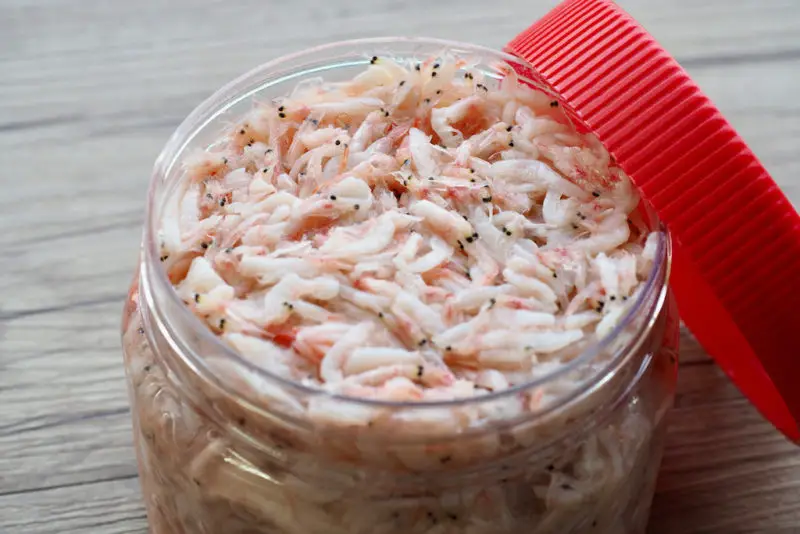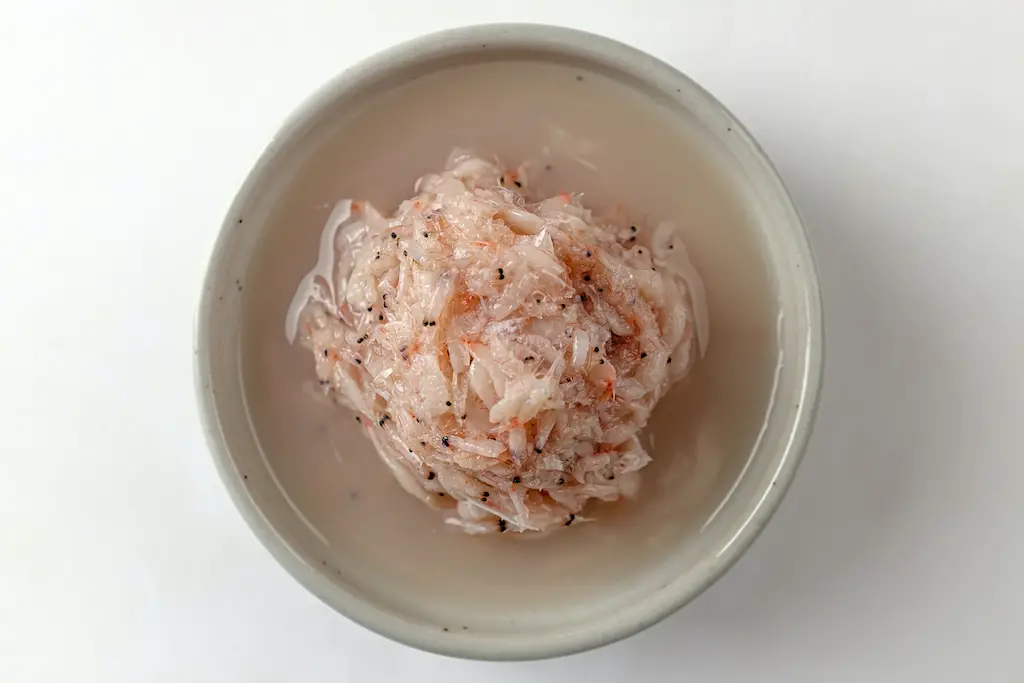This post may contain affiliate links. Please read my disclosure for details at the bottom of this page. As an Amazon Associate, I earn from qualifying purchases on this article about fermented salted shrimp in Korean cooking. We hope you enjoy learning about saeujeot!
Previously, on Carving A Journey, I wrote an article about aekjeot, otherwise known as Korean fish sauce. There, I discussed a variety of different fermented fish in Korean cuisine. In this post, I wanted to discuss one of those varieties I mentioned in that article: saeujeot! In South Korea, people commonly use this salted shrimp ingredient to make all different sorts of kimchi.
Let’s discuss this ingredient in-depth! Shall we start?
What Is Saeujeot?
Fermented salted shrimp is a traditional fermented condiment used to make some of South Korea’s most famous dishes, such as kimchi. In the Korean language, the word for these shrimp is ‘saeujeot’ or ‘saeu-jeot’ (새우젓). The term is a combination of two words: The first being ‘saeu’ (새우), meaning ‘shrimp,’ and the second being ‘jeot’ (젓), meaning ‘salted seafood.’
Like Korean fish sauce (aekjeot), saeujeot is a type of jeotgal. The term ‘jeotgal’ (젓갈) refers to a variety of different salted and preserved seafood used as ingredients in Korean cuisine. Examples of preserved seafood include shrimp, oysters, clams, roe, and fish. Traditionally, you can have a range of jeotgal which include seafood prepared in large pieces, tiny bites, or pure liquid.
Saeujeot falls into the category of smaller jeotgal because of the size of the shrimp. Compared to ordinary shrimp, the species used to make saeujeot are incredibly small with thin shells. In South Korea, people refer to this variety of shrimp as jeot-saeu (젓새우).
How Do You Make Fermented Salted Shrimp?
Traditionally, people make saeujeot by preserving these tiny shellfish in a large barrel. But first, they prepare the shrimp by tossing them in salt. Often, this is done on the boats by the fisherman for preliminary preservation during the warmer months.
Then, on land, people layer the shrimp at the bottom of a barrel before covering them in another layer of salt. The barrel is then sealed for an extended period in the shade at low temperatures so the shrimp do not rot.
As the shrimp ferments, the naturally occurring lactic acid breaks down the proteins. Not only does this allow the shellfish to soften, but it also brings out the strong umami flavor that this ingredient is famous for.

Types of Saeujeot:
Traditionally, the type of saeujeot depends on the season when the shrimps are harvested:
- First, Putjeot (풋젓) is traditionally made with shrimp harvested from the end of January through April in the lunar calendar. Other terms used to describe this style of saeujeot include deddeugi jeot (데뜨기젓) or dotddegi jeot (돗떼기젓).
- Then, during May, people refer to saeujeot as Ojeot (오젓).
- Once the weather heats up, people refer to saeujeot as Yukjeot (육젓), aka ‘sixth-month jeot.’ People harvest these shrimps in June. In South Korea, people regard these as the highest quality of fermented salted shrimp. Typically, these shrimps have the best flavor and are the preferred ingredient when making kimchi.
- Then, Chajeot (차젓) refers to shrimp harvested in July.
- As the weather cools, people start harvesting Gonjaeng-ijeot (곤쟁이젓) or jahajeot (자하젓). These tiny shrimp are the smallest harvested throughout the year. You harvest these in the area where freshwater mixes with the seawater off the western coast of Korea in the Yellow Sea.
- Chujeot (추젓) refers to another small shrimp harvested throughout the autumn. These are typically smaller and have a cleaner taste.
- Finally, people harvest and make Dongjeot (동젓) during November.
This is just an overview of saeujeot. There are more varieties not listed here on this list.
Saeujeot In Korean Cooking:
As I stated above, people in South Korea refer to fermented salted shrimp as ‘saeujeot’ (새우젓).
Most commonly, people use saeujeot to make kimchi. Beyond kimchi, people use this ingredient to make various dipping sauces and stews.
Saeujeot Frequently Asked Questions:
Now that we learned about Korean fermented salted shrimp (saeujeot), we want to answer some questions you may have about this ingredient! If we do not answer your question, feel free to leave a comment in the section below or email us at [email protected].
What Does Fermented Salted Shrimp Taste Like?
By itself, saeujeot strongly smells of the sea with an overpowering salty taste. As such, people do not eat it alone. Rather, you only use it as a flavor-enhancing ingredient in dishes.
Once combined with other ingredients, saeujeot provides depth and umami complexity to the dish without overpowering the other flavors.

Is This Gluten-Free?
As always, it depends. While saeujeot is naturally gluten-free, this ingredient may contain gluten depending on the production facility. When buying salted shrimp, always check the label. Sometimes, companies produce these items on machinery that also uses gluten-containing ingredients. Never assume it is gluten-free!
How Should I Store the Fermented Salted Shrimp?
You should always store this ingredient sealed in the original jar. Before and after opening, place these salted shrimps in the refrigerator.
Where Can I Buy Korean Fermented Salted Shrimp?
Unfortunately, you cannot find this ingredient in well-stocked western grocery stores. Instead, you need to shop for this at your local family-run Korean market or large Asian grocery chain (such as H-Mart).
If you do not live near an Asian grocery, you can order this ingredient online!
When shopping for this ingredient, look for shrimps that are fully intact and not falling apart. You want to buy shrimps that still have a vibrant color without cloudy eyes.
How Long Does This Ingredient Last?
If the saeujeot is fresh, these tiny salted shrimps can last in the refrigerator for 6 months to a year. Always check the expiration date set by the manufacturer.
Also, always do a visual check as well as a smell check before use. If the liquid has become cloudy and the shrimp smell bad, you know that the jar of saeujeot has gone rancid. At this point, I recommend throwing them away immediately.
What Is a Saeujeot Substitute?
If you cannot find these mini salted shrimps, you can substitute them for Korean fish sauce. Of the three varieties mentioned in our article about Korean fish sauce, I recommend Korean anchovy sauce.
Is There a Vegan Substitute?
These days, you can find vegan fish sauce on the market! Often, companies make vegan fish sauce using seaweed, soybean, or a mixture of vegan-based seasonings. That being said, I have yet to attempt making kimchi or other Korean recipes using a vegan substitute. Once I do, I will update the information here!
We Hope You Enjoyed Learning About Korean Fermented Salted Shrimp!
In the end, we hope you enjoyed learning about Korean fermented salted shrimp (saeujeot)! If so, let us know in the comment section!
If you would like to read more about cooking, you can find further recipes on our blog. We listed some of our favorite Carving A Journey Korean recipes below! For reference, many recipes are influenced by our blended Korean and Southern heritage.
Korean Ingredient Articles:
Further Carving A Journey Korean Recipes:
If you have any questions or comments, you can also email us at [email protected].
And, finally, we would love to hear from you through our social media as well! You can follow us at @carvingajourney on Instagram, Facebook, and Pinterest. I also started a vlog Youtube channel! Or, if you would like more articles like these, you can subscribe to our blog by joining our mailing list. Let us know if you make anything with Korean fermented salted shrimp (saeujeot)! Thank you so much for stopping by!
Carving A Journey is a participant in the Amazon Services LLC Associates Program, an affiliate advertising program designed to provide a means for sites to earn advertising fees by advertising and linking to Amazon.com. Although we may earn commissions for our endorsement, recommendation, testimonial, and/or link to any products or services from this website, these opinions are my own and I fully support these products.

